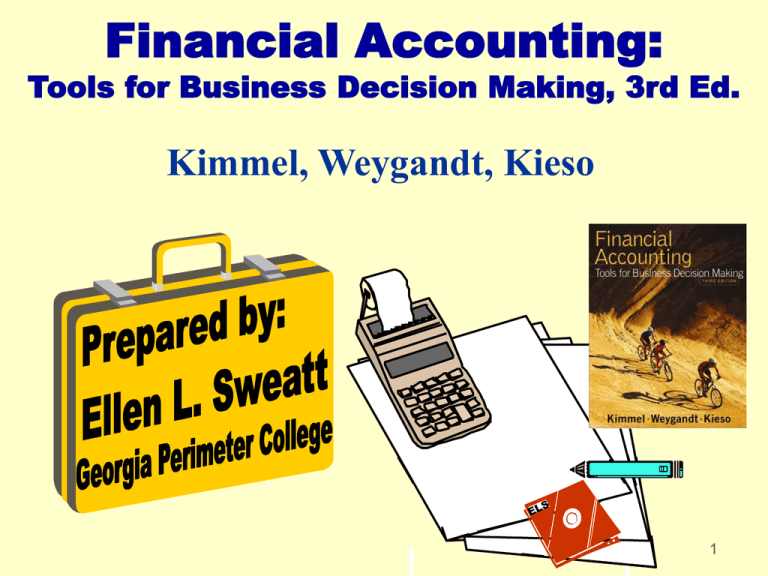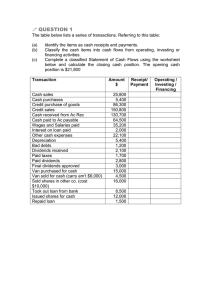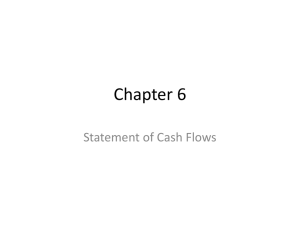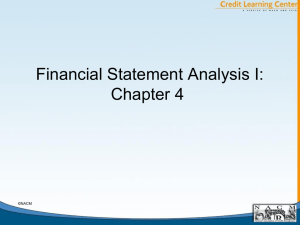
Financial Accounting:
Tools for Business Decision Making, 3rd Ed.
Kimmel, Weygandt, Kieso
1
Chapter
12
`
2
Chapter 12
Statement of Cash Flows
After studying Chapter 12, you should be
able to:
Indicate the primary purpose of the statement of cash
flows.
Distinguish among operating, investing, and financing
activities.
Explain the impact of the product life cycle on a
company's cash flows.
Prepare a statement of cash flows using one of two
approaches:
(a) the indirect method, or
(b) the direct method.
3
Use the statement of cash flows to evaluate a company.
The Primary Purpose of the
Statement of Cash Flows Is...
To provide information about:
cash receipts,
cash payments, and
the net change in cash
resulting from:
operating,
investing, and
financing activities of a
company during a period.
4
Questions the Statement of
Cash Flow Answers
5
Operating Activities...
Include:
The cash effects of transactions
that create revenues and expenses
and
Enter into determination of net
income.
Involve Income Statement Items
6
Investing Activities...
Include:
Purchasing and disposing of
investments and productive
long-lived assets using cash and
Lending money and collecting
the loans.
Involve Investments and
Noncurrrent Asset Items
7
Financing Activities...
Include:
Obtaining cash from issuing debt
and repaying the amounts
borrowed and
Obtaining cash from stockholders
and paying dividends.
Involve Noncurrent Liability and
Stockholders’ Equity Items
8
Illustration 12-1
Types of Cash Flows Operating Activities
Cash inflows:
From sale of goods or services
From return on loans (interest
received) and on equity securities
(dividends received)
Cash outflows:
To suppliers for inventory
To employees for services
To government for taxes
To lenders for interest
To others for expenses
9
Illustration 12-1
Types of Cash Flows Investing Activities
Cash inflows:
From sale of property, plant, and
equipment
From sale of debt or equity securities of
other entities
From collection of principal on loans to
other entities
Cash outflows:
To purchase property, plant, and
equipment
To purchase debt or equity securities of
10
other entities
Illustration 12-1
Types of Cash Flows Financing Activities
Cash inflows:
From sale of equity securities
(company's own stock)
From issuance of debt (bonds and
notes)
Cash outflows:
To stockholders as dividends
To redeem long-term debt or
reacquire capital stock
11
Operating Activities - ALERT
Some cash flows relating to investing or
financing activities are classified as operating
activities. For example...
Receipts of investment revenue (interest
and dividends) and
Payments of interest to lenders are
classified as operating activities because
these items are reported in the income
statement.
12
Significant
Noncash Activities...
That do NOT affect cash are NOT reported
in the body of the statement of cash flows.
Are reported:
In a separate schedule at the bottom of
the statement of cash flows or
In a separate note or supplementary
schedule to the financial statements.
13
Significant
Noncash Activities...
1. Issuance of common stock to purchase
assets.
2. Conversion of bonds into common stock.
3. Issuance of debt to purchase assets.
4. Exchanges of plant assets.
14
Format of the
Statement of Cash Flows
Three parts:
operating
investing
financing
Plus significant noncash investing and
financing activities in separate schedule
or at bottom of the statement of cash
flows.
15
Format of the Statement of
Cash Flows
Three activities:
operating
investing
Body of
Statement
financing
PLUS
noncash investing and
financing activities
16
The Product Life Cycle
A series of phases all products go
through
The phases are often referred to
as the:
introductory phase
growth phase
maturity phase
decline phase.
The phase a company is in affects
its cash flows.
17
Introductory Phase
To support asset purchases the
company may issue stock or debt.
Expect:
cash from operations to be
negative.
cash from investing
to to be negative.
cash from financing
to be positive.
18
Growth Phase
The company is striving to expand
its production and sales.
Expect:
small amounts of cash to be
generated from operations.
cash from investing to be
negative.
cash from financing to be
positive.
19
Maturity Phase
Sales and production level-off
Expect:
cash from operations to exceed
investing needs.
cash from investing
to be neutral.
cash from financing
to be negative.
20
Decline Phase
Sales and production decline
Expect:
cash from operations to decline
cash from investing to
possibly become
positive.
cash from financing
to possibly become
negative
21
Impact of Product Life Cycle on Cash Flows
0
22
Why Report the Causes of
Changes in Cash?
Because investors, creditors, and
other interested parties want to now
what is happening to a company’s
most liquid asset,
CASH
23
Statement of Cash Flows
Helps Users Evaluate
1. The entity's ability to generate future cash flows
2. The entity's ability to pay dividends and meet
obligations
3. The reasons for the difference between net
income and net cash provided (used) by
operating activities
4. The investing and financing transactions during
the period
24
Statement of Cash Flows Helps
Answer the Following Questions
How did cash increase when there was a net loss
for the period?
How were the proceeds of the bond issue used?
How was the expansion in the plant and
equipment financed?
Why were dividends not increased?
How was the retirement of debt accomplished?
How much money was borrowed during the
year?
Is cash flow greater or less than net income?
25
Sources of Information for the
Statement of Cash Flows
Comparative balance sheet
Current income statement
Additional information
26
Comparative Balance Sheet
Indicates the amount of
changes in assets,
liabilities, and stockholders'
equities from the beginning
to the end of the period.
27
COMPUTER SERVICES COMPANY
Comparative Balance Sheet
December 31, 2003
Assets
Cash
Accounts
receivable
Equipment
Total
Liabilities and
stockholders’
equity
Accounts payable
Common stock
Retained
earnings
Total
Dec. 31, Jan.1,
2003
2003
$34,000
$0
30,000
0
10,000
$74,000
Increase/Decrease
$34,000 increase
30,000 increase
0
$0
10,000 increase
$4,000
50,000
20,000
$0
0
0
$4,000 increase
50,000 increase
20,000 increase
$74,000
$0
28
Current Income Statement
Information in this
statement helps the
reader determine the
amount of cash
provided or used by
operations during the
period.
29
Income Statement and
Additional Information
COMPUTER SERVICES COMPANY
Income Statement
For the Year Ended December 31, 2003
Revenues
Operating expenses
Income before income taxes
Income tax expense
Net income
$85,000
40,000
45,000
10,000
$35,000
Additional Information:
(a) Examination of selected data indicates that a
dividend of $15,000 was declared and paid during
the year.
(b) The equipment was purchased at the end of 2003.
30
No depreciation was taken in 2003.
Indirect and Direct Methods
Convert net income from an accrual
basis to a cash basis.
This conversion may be done
by two methods:
indirect
direct
31
Indirect and Direct Methods
Both methods arrive at the same total
amount for “Net cash” provided by
operating activities.
The methods differ in disclosing the
items that make up the total amount.
The choice of methods affects only the
operating activities section; the
investing and financing activities
sections are the same.
32
Indirect Method
The indirect method is used extensively
in practice.
Most companies favor the indirect
method for the following reasons:
it is easier to prepare
it focuses on the differences between net
income and net cash flow from operating
activities
it tends to reveal less company information
to competitors.
33
Direct Method
The FASB prefers the direct method but
allows the use of either method.
When the direct method is used, the net
cash flow from operating activities as
computed using the indirect method must
also be reported in a separate schedule.
34
Steps in Preparing
Statement of Cash Flows
$34,000 - 0 = $34,000
35
Statement Of Cash Flows Indirect Method
The transactions of Computer Services
Company for the year ended 2003 are used to
illustrate the preparation of a statement of cash
flows .
Computer services Company started in
January 1, 2003, when it issued 50,000 shares of
$1 par value common stock for $50,000 cash.
The company rented its office space and
furniture and performed consulting services
throughout the first year.
36
Steps in Preparing
Statement of Cash Flows
37
Determine Net Cash Provided/Used
By Operating Activities
Adjust net income for items that did not
affect cash.
Net income must be converted because
earned revenues may include credit sales
that have not been collected in cash and
expenses incurred that may not have been
paid in cash.
38
Net Income Versus Net Cash
Provided by Operating Activities
Add Cash advances
Deduct prepaid expenses
39
Determine Net Cash Provided/Used
By Operating Activities
Receivables, payables, prepayments,
and inventories must be analyzed for
their effects on cash.
40
Determine Net Cash Provided/Used
By Operating Activities
Computer Services Company had revenues
of $85,000 in its first year of operations.
However, CSC collected only $55,000 in cash.
Accrual basis revenue was $85,000, cash basis
revenue would be $55,000.
The increase in accounts receivable of
$30,000 must be deducted from net income.
If accounts receivable decrease, the decrease
must be added to net income.
41
COMPUTER SERVICES COMPANY
Statement of Cash Flows--Indirect Method (Partial)
For the Year Ended December 31, 2003
Cash flows from operating activities
Net income
$35,000
Adjustments to reconcile net income to
net cash provided by operating activities:
Increase in accounts receivable
$(30,000)
42
Determine Net Cash Provided/Used
By Operating Activities
Accounts payable - When accounts payable increase
during a year, operating expenses on an accrual
basis are higher than they are on a cash basis.
For CSC, operating expenses reported in the income
statement were $40,000.
Since Accounts Payable increased $4,000, $36,000
($40,000 – $4,000) of the expenses were paid in cash.
To convert net income to net cash provided by
operating activities, an increase in accounts payable
must be added to net income, a decrease subtracted.
43
COMPUTER SERVICES COMPANY
Statement of Cash Flows--Indirect Method (Partial)
For the Year Ended December 31, 2003
Cash flows from operating activities
Net income
$35,000
Adjustments to reconcile net income to
net cash provided by operating activities:
Increase in accounts receivable
$(30,000)
Increase in accounts payable
4,000 (26,000)
Net cash provided by operating activities
$ 9,000
44
Steps in Preparing
Statement of Cash Flows
45
Determine Net Cash Provided/Used
By Investing and Financing Activities
No data are given for the increases in Equipment
of $10,000 and Common Stock of $50,000. Assume
any differences involve cash.
The increase in equipment is from a purchase of
equipment for $10,000 cash. This purchase is
reported as a cash outflow in the investing
activities section.
The increase of common stock results from the
issuance of common stock for $50,000 cash. It is
reported as an inflow of cash in the financing
activities section of the statement of cash flows. 46
COMPUTER SERVICES COMPANY
Comparative Balance Sheet
December 31, 2003
Assets
Cash
Accounts
receivable
Equipment
Total
Liabilities and
stockholders’
equity
Accounts payable
Common stock
Retained
earnings
Total
Change
Increase/Decrease
Dec. 31,
2003
$34,000
30,000
Jan. 1,
2003
$0
0
10,000
$74,000
0
$0
10,000 increase
$4,000
50,000
20,000
$0
0
0
$4,000 increase
50,000 increase
20,000 increase
$74,000
$0
$34,000 increase
30,000 increase
47
Determine Net Cash Provided/Used
By Investing and Financing Activities
Reasons for the increase of $20,000 in the
Retained Earnings.
Net income increased retained earnings by
$35,000. REPORTED IN THE OPERATING
ACTIVITIES SECTION.
The additional information indicates that a
cash dividend of $15,000 was declared and
paid. REPORTED IN THE FINANCING
ACTIVITIES SECTION.
48
COMPUTER SERVICES COMPANY
Statement of Cash Flows--Indirect Method (Partial)
For the Year Ended December 31, 2003
Cash flows from operating activities
Net income
$35,000
Adjustments to reconcile net income to
net cash provided by operating activities:
Increase in accounts receivable $(30,000)
Increase in accounts payable
4,000 (26,000)
Net cash provided by operating activities
$ 9,000
Cash flows from investing activities
Purchase of equipment
(10,000)
Cash flows from financing activities
Issuance of Common Stock
$50,000
Payment of cash dividends
(15,000)
Net cash provided by financing activities
35,000
49
Net increase in cash
$34,000
Major Classes of Cash Receipts
and Payments -- Direct Method
50
Formula to Compute Cash Receipts
from Customers-Direct Method
51
Formula to Compute Cash Payment to
Suppliers-Direct Method
52
Formula to Compute Cash Payments for
Operating Expenses-Direct Method
53
COMPUTER SERVICES COMPANY
Statement of Cash Flows--Direct Method (Partial)
For the Year Ended December 31, 2003
Cash flows from operating activities
Cash receipts from customers
$ 765,000
Cash payments
To supplier
$550,000
For operating expenses
158,000
For income taxes
48,000 756,000
Net cash provided by operating activities
$ 9,000
54
Free Cash Flow
In the statement of cash flows, cash from
operations is intended to indicate the cashgenerating capability of the company.
Statement of Cash flows fails to take into
account that a company must invest in new
fixed assets to maintain its current level of
operations and it must maintain dividends
at current levels to satisfy investors.
55
Free Cash Flow
Cash Provided By Operations
–
Capital Expenditures
–
Dividends Paid
Free Cash Flow
56
Using Cash Flows
to Evaluate a Company
The 2001 statement of cash flows of Microsoft
Corporation provides information for the computations
of these measures.
MICROSOFT CORPORATION
STATEMENT OF CASH FLOWS (PARTIAL)
2001
Cash flows from operations
$13,422
Additions to property, plant,
and equipment
$ (1,103)
Other assets and investments
( 66,346)
Short-term investments
58,315
Cash used by investing activities
(9,134)
Cash paid for dividends on preferred stock
(0)57
MICROSOFT CORPORATION
STATEMENT OF CASH FLOWS (Partial)
2001
Cash flows from operations
13,422
Less: Expenditures on property, plant,
and equipment
1,103
Dividends
z
0
Free Cash Flow
12,319
58
Assessing Liquidity, Solvency, and
Profitability Using Cash Flows
Rather than using numbers from the
income statement for assessment
purposes, we use numbers from the
statement of cash flows.
The ratios are cash-based instead
of accural-based.
59
Cash-Based Measures
Accrual-based measures
allows too much
management discretion.
One disadvantage to the
cash-based measures is no
readily available published
industry averages for
comparison.
60
Liquidity
Liquidity is the ability of a business
to meet its immediate obligations.
One measure of liquidity is the
current ratio.
A disadvantage of the current
ratio is that it uses year-end
balances of current assets and
current liabilities (may not be
representative of a company's
position during most of the year.)
61
Current Cash Debt
Coverage Ratio
A ratio that partially corrects this is the
current cash debt coverage ratio.
Cash provided by operations
Average current liabilities
Since cash from operations involves the entire
year rather than a balance at one point in
time, it is often considered a better
representation of liquidity on the average day.
62
Solvency
Solvency is the ability of a firm to survive over
the long term.
One measure of solvency is the debt to total assets
ratio.
A measure of solvency that uses cash figures is
the cash debt coverage ratio.
Cash Provided By Operations
Average Total Liabilities
This ratio measures a company's ability to repay its
liabilities from cash generated from operations.
63
Profitability
Profitability refers to a company's ability
to generate a reasonable return.
Accrual-based ratios that measure
profitability are gross profit rate, profit
rate margin, and return on assets.
A cash-based measure of performance is
the cash return on sales ratio.
64
COPYRIGHT
Copyright © 2004, John Wiley & Sons, Inc. All rights reserved.
Reproduction or translation of this work beyond that permitted in
Section 117 of the 1976 United States Copyright Act without the
express written permission of the copyright owner is unlawful.
Request for further information should be addressed to the
Permissions Department, John Wiley & Sons, Inc. The purchaser
may make back-up copies for his/her own use only and not for
distribution or resale. The Publisher assumes no responsibility
for errors, omissions, or damages, caused by the use of these
programs or from the use of the information contained herein.
65








